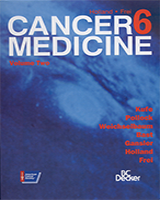By agreement with the publisher, this book is accessible by the search feature, but cannot be browsed.
NCBI Bookshelf. A service of the National Library of Medicine, National Institutes of Health.
Kufe DW, Pollock RE, Weichselbaum RR, et al., editors. Holland-Frei Cancer Medicine. 6th edition. Hamilton (ON): BC Decker; 2003.

Holland-Frei Cancer Medicine. 6th edition.
Show detailsRegulation of the reproductive axis begins at the level of the hypothalamus, where neurosecretory cells synthesize and release gonadotropin-releasing hormone (GnRH) in pulsatile fashion into the hypothalamic-hypophysial-portal circulation. In response, gonadotropes in the anterior pituitary synthesize and release the gonadotropins follicle-stimulating hormone (FSH) and luteinizing hormone (LH), both of which ultimately control gonadal function. In women, ovarian follicles are stimulated by FSH to grow and mature; LH stimulates ovulation and corpus luteum formation. In men, FSH initiates, and in conjunction with high intratesticular testosterone, sustains spermatogenesis, whereas LH controls androgen synthesis by the testicular Leydig cells. In both men and women, gonadal failure results in increased LH, because of loss of the negative feedback of estrogen at the hypothalamus and pituitary in women and from decreases in both androgen and estrogen feedback in men. In response to decreased levels of sex steroids as well as the loss of inhibin, FSH levels are also elevated following gonadal damage. Serum gonadotropin and sex steroid values will differentiate between reproductive failure at the gonadal level or at the hypothalamic/pituitary level. Sex steroid levels will be low in both, but serum gonadotropin levels will be high in primary gonadal failure and low in those with hypothalamic or pituitary disease. Thus, the hallmark of primary gonadal failure from any cause is elevation of gonadotropin levels, and this is the usual state in postpubertal patients receiving substantial doses of antineoplastic agents. Cranial radiation, on the other hand, may result in significant hypothalamic-pituitary dysfunction and secondary gonadal failure with low serum levels of gonadotropins.
- The Hypothalamic-Pituitary-Gonadal Axis - Holland-Frei Cancer MedicineThe Hypothalamic-Pituitary-Gonadal Axis - Holland-Frei Cancer Medicine
- Taxonomy Links for Nucleotide (Select 3934099) (1)Taxonomy
- PMC Links for GEO Profiles (Select 126668736) (4)PMC
Your browsing activity is empty.
Activity recording is turned off.
See more...